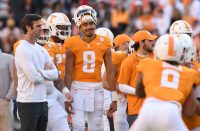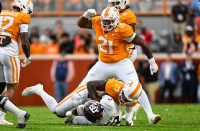When the Vols finally kick off in a couple of weeks, all eyes will be drawn to the shiny objects. We’ll scan the field in search of Wanya Morris, Darnell Wright, Henry To’oTo’o, and Quavaris Crouch, and we’ll hope to see them doing well. The new blood is always the first place we look when searching for hope.
But hope is found not only in new faces or in lag measures like win/loss records. It’s also found in lead measures, those details that lead to the final results you’re after, and you don’t have to wait until the end to analyze those.
We here at GRT are as interested in the new guys as everyone else, but we’ll also be looking closely at certain details, those specific lead measures that will likely foretell final success or failure long before it happens.
Here’s a partial list of the lead measures we’ll be watching when the team kicks off this fall. Will covered some of this in series earlier this summer, but I wanted to gather them all here for the late arrivals and for the purpose of adding to the conversation.
Lead measure No. 1: More third-and-short conversions
Here’s the worst of the bile from that article:
Last year Tennessee ran the ball 21 times on 3rd-&-1-to-3. They gained just 20 yards. Those 0.95 yards per carry on third-and-short weren’t just last in the country: Liberty finished 129th, and averaged 1.52 yards per carry. The Vols were the only team in America to average less than a yard-and-a-half per carry on third-and-short, and the Vols averaged less than a yard period.
Ugh.
For my money, this is the thing I’m most interested to see this fall. The early returns will serve as the best prognosis for the offensive line.
The fact that the fate of the 2019 Volunteers is primarily in the big paws of the big men up front on offense is one of college football’s worst-kept secrets. They have additional goals, no doubt — keeping Jarrett Guarantano in one piece and on the field, giving him time to throw, keeping tackles for loss to a minimum, and providing the running backs with sufficient time and space to improve their overall yards per carry regardless of down — but productivity on third-and-short is the canary in the coal mine, and we like our canaries alive, thank you very much.
What to watch for: To be average in this category, the Vols should get somewhere around 4.5 yards on third down with 1-3 yards to go. To be one of the best 25 teams in this category, we’d want to see them get around 5.5 yards.
Lead measure No. 2: More yards per carry regardless of down
The allocation of credit for an offense’s productivity running the ball is an age-old question. The guy carrying the ball gets all of the glory, of course, but he’d get nowhere without his blockers. How much credit to give the big guys, though, is up for debate. I’m inclined to give them a bunch.
So, when a running back struggles, it makes sense to lay much of the blame on the offensive line as well.
Tennessee last season averaged only 3.7 yards per carry, ranking 108th in the nation. If that number improves this fall, it should indicate that the offensive line has indeed improved and the canary lives another day.
What to watch for: Tennessee could work its way into mediocrity by reaching somewhere around 4.5 yards per carry. Over 5 should get them into the Top 25.
Lead measure No. 3: More takeaways
The juicy bit from that piece from Will:
The result: just 15 turnovers in each of the last two seasons, 97th nationally in 2017 and 101st in 2018 (stats via SportSource Analytics). That total joins anemic defenses from 2011 (18 turnovers), 2012 (17), and a what-could-have-been unit from 2015 (19 turnovers) in Tennessee failing to break 20 turnovers five times in the last eight years.
Note that this is “turnovers gained,” not “turnover margin.” The Vols were pretty good at protecting the ball when they had it last season, ranking 30th nationally in turnovers lost. They just weren’t very good at taking it away from the other team.
What to watch for: You’d like to see the Vols get at least around 20 turnovers, so maybe 1.6 or so per game to stay on pace. That’s just to get to the median, though. If you’re shooting for the best 25, you want to see somewhere around 24, or an average of 2 per game.
As Will points out in the above article, one of the leading causes of turnovers is sacks, because a sack is a two-pronged problem for an offense. First, they’re often a surprise to the quarterback, who’s not protecting the ball but getting ready to throw it, so he’s more likely to fumble it when hit. Second, even if the quarterback does manage to throw it with an animal bearing down on him, the pressure of a near-sack greatly increases the odds of an interception.
And that brings us to . . .
Lead measure No. 4: More sacks
Bad news: Tennessee had only 25 sacks all of last season, good for only 67th in the nation.
More bad news: 9 of those came from Kyle Phillips, Alexis Johnson, Emmitt Gooden, and Darrin Kirkland, Jr., none of whom will take the field this fall.
Good news: returning outside linebacker Darrell Taylor contributed 8 of them.
Bad news: 7 of Taylor’s sacks came in only two games.
Good news: Those two games were against Georgia and Kentucky, two of the season’s toughest opponents/most important games.
More good news: Everybody knows consistency is the theme of the season for Taylor, and a little additional focus should go a long way for such a talented dude. Derek Barnett had 13 in 2016 with only four goose eggs. He had 1 sack in 6 games, 2 in 2, and 3 in 1. That’s your target, Mr. Taylor.
More bad news: Every opponent knows all of this about Taylor as well, so he’s going to get extra attention from the pass-blockers. This, of course, will create opportunities for Taylor’s teammates.
What to watch for: Tennessee’s ability to generate more sacks this season is one of the main games-within-the-games to watch this fall. They averaged 2.08 sacks per game last season, and we’d like to see an improvement to 2.75 per game this fall. The question marks along the all-new defensive line will make this especially interesting.
Lead measure No. 5: Improved red zone defense
Back to Will for more astonishment:
Opponents converted 41 of 45 red zone opportunities against the Vols last year, 91.1%, and only two of those four stops came in meaningful situations. That scoring percentage ranked 120th nationally last fall. Opponents scored touchdowns 30 times in those 45 trips; a 66.7% red zone touchdown percentage ranked 90th nationally. (stats via SportSource Analytics)
My first inclination upon seeing this is to simply say that it’s correlated with a defense that was bad everywhere, but that’s really not the case. Tennessee was 49th in total defense, 52nd in rushing defense, and 60th in passing yards allowed. That’s not good, of course, but it doesn’t explain 90th and 120th in red zone touchdowns allowed and red zone scoring allowed.
So what’s the answer here?
I have no idea.
I am intrigued by something I read suggesting that football gets less speedy and more twitchy as the field shrinks and that therefore not knowing what to do matters more because it puts you at an instinctual disadvantage. But I’m not really sold on that idea, either. My humble advice: Do better. 🙂
What to watch for: The target for how often an opponent scores when in the red zone is about 82% for just good and about 76% for really good. Either of those would show improvement.
Bonus measure: More Guarantano, less medical tent
Jarrett Guarantano is better than you think he is. The team needs to protect him better and provide him more time and space to operate so that he can stay on the field instead of the medical tent while the trainers put Humpty back together again.
The odd thing is, the offense wasn’t nearly as terrible at allowing sacks as you might think. Opponents managed 1.92 sacks per game against the Vols, which puts Tennessee at 47th in the nation. Again, a galaxy far, far away from home, but not as bad as it seemed.
I think the real problem is that not all sacks are equal and that each one Guarantano suffered felt like a catastrophe and made you legitimately concerned for his long-term well-being. That, and the fact that 39% of his throws last season were made under pressure.
As I said a couple of weeks ago, just a little more time from the offensive line and slightly quicker decisions from Guarantano should help the team reap the rewards of a quarterback who can be really, really good provided he gets the help he needs.
I’m not sure what stat to watch to monitor this. As far as I know, no one tracks hits on the quarterback that send him to the sideline, but having Guarantano remain on the field for every meaningful offensive snap is a good day.




Wow… some really interesting and insightful metrics! Got to improve or it will be another long season. Go Vols!